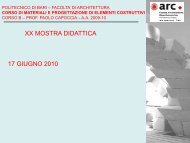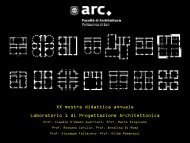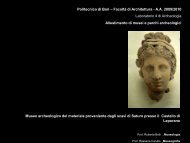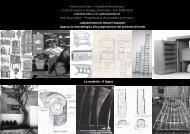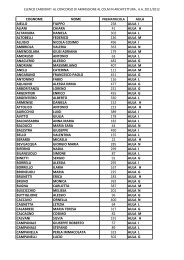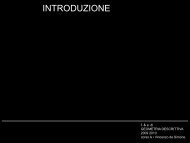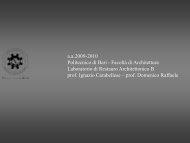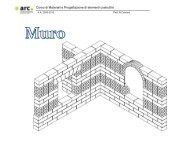44. I regolamenti <strong>di</strong>dattici102architectonic organism. Some reference w<strong>il</strong>lbe de<strong>di</strong>cate to the meaning of the actual trendof the construction project and of the deta<strong>il</strong>.Main issues of the lectures:1nd cycle of lectures• Characters and of bu<strong>il</strong><strong>di</strong>ng techniques ofAncient Greece• Principles of Construction and bu<strong>il</strong><strong>di</strong>ngtechniques in Ancient Roman Bu<strong>il</strong><strong>di</strong>ngs:Pantheon and Massenzio Bas<strong>il</strong>ica;• The Construction of Gothic Cathedral• Brunelleschi and Michelangelo: techniques,knowledge and materials in S. Maria del Fiore,Florence and S. Peter, Rome.• Evolution of the structural form: AlessandroAntonelli and Pierluigi NerviArchitecture and Technology in the moderncontemporary project.2nd cycle of lectures• The great roof: masonry, steel, reinforcedconcrete, timber.• Vertical and horizontal design solutions ofclad<strong>di</strong>ngs and partition. Internal partitions.• The solution of tectonic nodes and<strong>di</strong>scontinuities in walls.• Theory of intersection among systems,joints and tolerances.• Reference about the sense of architecturaldeta<strong>il</strong> project.• The bekleidung prinzip in the process ofrenewal of modern architecture.Iscrizione al corsoLe iscrizioni avvengono obbligatoriamentesulla piattaforma. Poiché <strong>il</strong> corso si svolgenel secondo semestre, è necessario, ai finidell’iscrizione, che lo studente abbiasostenuto tutte le propedeuticità previste.Modalità d’esameL’esame consiste in un colloquio sugliargomenti sv<strong>il</strong>uppati nelle lezioni.Fisica tecnica ambientale IApplied physics of the bu<strong>il</strong>t environment IIng-Ind 11-4 cfu3° anno / corso semestrale (I semestre)Area <strong>di</strong>dattica VI:Discipline fisico-tecniche e impiantisticheper l’architetturaFrancesco RuggieroFinalità e contenuti <strong>di</strong>sciplinariObiettivo del corso è fornire agli allievi iconcetti fondamentali delle <strong>di</strong>sciplinefisico-tecniche e impiantistiche perl’architettura.Le con<strong>di</strong>zioni <strong>di</strong> benessere termoigrometriconello spazio architettonicosono raggiunte spontaneamente con molta<strong>di</strong>fficoltà e quasi mai si mantengono neltempo senza <strong>di</strong>spen<strong>di</strong>o <strong>di</strong> energia. Infatti <strong>il</strong>controllo delle perturbazioni provenientidalla variab<strong>il</strong>ità delle con<strong>di</strong>zioni esternerichiede l’impiego <strong>di</strong> energia la cuiut<strong>il</strong>izzazione va ottimizzata con un attentostu<strong>di</strong>o sin dalle prime fasi progettuali delsistema e<strong>di</strong>ficio impianto. Pertanto,l’appren<strong>di</strong>mento teorico (sapere) e leapplicazioni progettuali (saper fare)saranno rivolte all’approfon<strong>di</strong>mento dellemetodologie ut<strong>il</strong>izzate nello stu<strong>di</strong>o e nelcontrollo dei fenomeni fisici che simanifestano nello spazio architettonico eche influenzano <strong>il</strong> benessere umano negliaspetti legati alla sua termoregolazione.A questo proposito sarà approfon<strong>di</strong>to lostu<strong>di</strong>o:• del benessere termoigrometrico;• della qualità dell’aria;• del b<strong>il</strong>ancio energetico degli e<strong>di</strong>fici;• degli impianti tecnologici a servizio delsistema costruito;• degli impianti <strong>di</strong> climatizzazione;• della <strong>di</strong>rettiva europea sul ren<strong>di</strong>mentoenergetico in ed<strong>il</strong>izia e della normativaitaliana del settore.Aims and contentsThe target of the course is to provide thefundamental concepts for the applicationof physical-techniques and the design oftechnical installations for the bu<strong>il</strong>tenvironment.In the architectural space the thermohygrometriccon<strong>di</strong>tions are <strong>di</strong>fficult to reachspontaneously and require a lot of energyto maintain. In fact the control of variab<strong>il</strong>itydue to external con<strong>di</strong>tions needs the use ofenergy, the production and ut<strong>il</strong>ization ofwhich must be carefully optimized from thefirst phases of bu<strong>il</strong><strong>di</strong>ng design. Therefore,the theoretical learning (knowledge) andthe design applications (knowhow) w<strong>il</strong>l be<strong>di</strong>rected to widening the range ofmethodologies used in the study andcontrol of physical phenomena inarchitectural space that influence humancomfort related to thermoregulation.To achieve this purpose investigationfocusses on:• thermo - hygrometric comfort;• indoor air quality;• energy balance of bu<strong>il</strong><strong>di</strong>ngs;• technical plant for bu<strong>il</strong><strong>di</strong>ngs;• air con<strong>di</strong>tioning systems;• the European <strong>di</strong>rective on the energyperformance of bu<strong>il</strong><strong>di</strong>ngs and the ItalianStandards.
Articolazione dell’attività <strong>di</strong>datticaIl tema del corso sarà rivolto allaconoscenza delle <strong>di</strong>verse tecnologieimpiantistiche, alla verifica delle con<strong>di</strong>zionitermo-igrometriche e <strong>di</strong> qualità dell’ariadegli ambienti confinati, nonchè al<strong>di</strong>mensionamento preliminare degliimpianti <strong>di</strong> con<strong>di</strong>zionamento.Il corso sarà coor<strong>di</strong>nato ed integrato alprogetto architettonico realizzato durante <strong>il</strong>Laboratorio 3 <strong>di</strong> Progettazionearchitettonica in modo tale da consentireagli allievi <strong>di</strong> eseguire la progettazione <strong>di</strong>una biblioteca, tenendo presente lecaratteristiche termofisiche dell’involucro el’integrazione degli impianti tecnologici.Articulation of educational activitiesThe theme of the course is the <strong>di</strong>fferentplant technologies and the control of thethermo- hygrometric con<strong>di</strong>tions and the airquality requirements in bu<strong>il</strong>t environments,as well as the preliminary design of aircon<strong>di</strong>tioninginstallations.The course w<strong>il</strong>l be coor<strong>di</strong>nated an<strong>di</strong>ntegrated with the architectural designrealized during Architectural Design Stu<strong>di</strong>o3 rd years, to allow the students to design alibrary, keeping in mind the thermo-physicalcharacteristics of bu<strong>il</strong><strong>di</strong>ng structures and theintegration of technical plant.Iscrizione al corsoLe iscrizioni avvengono obbligatoriamentesulla piattaforma. Per iscriversi lo studentedeve avere sostenuto tutte lepropedeuticità previste. È ammessal’iscrizione con riserva per quegli studentiche sosterranno tutte le propedeuticitàpreviste entro la sessione invernale. Lamancata verifica <strong>di</strong> questa con<strong>di</strong>zioneimplica a febbraio l’automatica decadenzadalla iscrizione al corso.Modalità d’esameL’esame è in<strong>di</strong>viduale. Consiste in unaverifica scritta eventualmente integrata dauna <strong>di</strong>scussione orale.Lo studente deve <strong>di</strong>mostrare:• <strong>di</strong> avere acquisito le competenze teoricheed operative necessarie per intervenirecriticamente, nelle scelte <strong>di</strong> caratteregenerale e nelle procedure estimative edanalitiche, nelle <strong>di</strong>versi fasi del processoprogettuale, sia tra<strong>di</strong>zionale cheinnovativo;• <strong>di</strong> aver sv<strong>il</strong>uppato la capacità <strong>di</strong> correlarele scelte progettuali impiantistiche a quellearchitettoniche, al fine <strong>di</strong> attivare unprocesso iterativo <strong>di</strong> controllo che conducaad una ottimizzazione complessiva.Teorie e tecniche della progettazioneurbanisticaTheories and Techniques of urbanplanningIcar 21-4 cfu3° anno / corso semestrale (II semestre)Area <strong>di</strong>dattica VIII:Progettazione urbanistica e pianificazioneterritorialeMaria MininniFinalità e contenuti <strong>di</strong>sciplinariL’assetto <strong>di</strong> un territorio e la forma urbana<strong>di</strong> una città sono frutto <strong>di</strong> vicende storiche,<strong>di</strong> con<strong>di</strong>zioni ambientali, <strong>di</strong> modalità <strong>di</strong> usodelle risorse, <strong>di</strong> rapporti produttivi esociali. Queste volontà si sono manifestate,almeno nell’ultimo secolo e mezzo,soprattutto attraverso piani e progettiurbanistici. Lo strumento rielaborato dallacultura urbanistica italiana è stato <strong>il</strong> PianoRegolatore.Tuttavia, gli scopi e i significati originari delpiano, recentemente, stannoprofondamente mutando.Il corso si propone <strong>di</strong> introdurre gli studentialla progettazione urbanistica e <strong>di</strong> fornireloro:-un apparato teorico e critico necessario aconoscere e comprendere gli strumenti <strong>di</strong>pianificazione locale, visti nel percorsoevolutivo dal piano <strong>di</strong> tra<strong>di</strong>zione a nuoveforme <strong>di</strong> piano (sapere);-un metodo <strong>di</strong> costruzione del progettourbanistico, fondato su tecnicheinterpretative della realtà e delle suetrasformazioni che ne evidenzi i sistemicostitutivi e le relazioni che li legano (saperfare).Aims and contentsThe planning of a territory and the urbanform of a city are the outcome of historicalvicissitudes, environmental con<strong>di</strong>tions, ofthe use of resources, and of productive andsocial relationships. These factors havebeen manifested, at least in the last onehundred and fifty years, above all in theform of urban plans and designs. The toolset up by the Italian urban planning cultureis the “Piano Regolatore” (Town Plan).However, the purposes and originalmeaning of the town plan are nowundergoing significant changes.The objective of the course is to introducestudents to urban planning and to givethem:- the necessary theoretical and criticalapparatus to recognize and understand thetools of local planning, seen from theevolutionary standpoint as thedevelopment from the tra<strong>di</strong>tional plan tonew forms of planning (knowledge basis);- a method for urban design, founded uponinterpretative techniques of the reality an<strong>di</strong>ts transformations, that underline thesystems that gave rise to these and therelationships that connect them (knowhow).Articolazione delle attività <strong>di</strong>datticheIl progetto urbanistico costituisce <strong>il</strong> temacentrale del corso che si articola inmomenti <strong>di</strong>stinti:-la città dei piani: le teorie dellaprogettazione urbanistica che hannocondotto al piano moderno;44.2.10 Progetti <strong>di</strong>dattici del II ciclo del CdLm in Architettura103
- Page 1:
0607Politecnico di BariFacoltà di
- Page 4 and 5:
Politecnico di Bari, Facoltà di Ar
- Page 6 and 7:
4. Regolamenti didattici4.1. Il Reg
- Page 8 and 9:
PresentazionePresentazioneLa Facolt
- Page 11 and 12:
Le strutture didattiche e di suppor
- Page 13 and 14:
giorno e dando, quindi, esecutivit
- Page 15 and 16:
• esprimere pareri sui compiti di
- Page 17 and 18:
1.3. La Biblioteca di FacoltàIl pa
- Page 19 and 20:
2. Strutture di ricerca e di suppor
- Page 21 and 22:
BIO 07, Ecologia43 Mariavaleria Min
- Page 23 and 24:
le richieste e le iniziative ad ess
- Page 25:
2.3 Le biblioteche d’area2.3.1 Le
- Page 28 and 29:
33. La didattica e gli studenti263.
- Page 31 and 32:
4. I Regolamenti didattici4.1. Rego
- Page 33 and 34:
presente regolamento;• le propede
- Page 35 and 36:
discussi ed i voti finali.Per ciasc
- Page 37 and 38:
4.2.4 Definizione delle aree discip
- Page 39 and 40:
laurea da attivare in base al numer
- Page 41 and 42:
non venga superato l’iscrizione a
- Page 43 and 44:
Manifesto del CdLs in Architettura
- Page 45 and 46:
Manifesto del CdLm in Architettura
- Page 47 and 48:
ciclo provenendo da altri Atenei.È
- Page 49 and 50:
Manifesto del CdLs in Architettura
- Page 51 and 52:
Manifesto del CdLm in Architettura
- Page 53 and 54: Insegnamenti ssd Crediti Laboratori
- Page 55 and 56: Insegnamenti ssd Crediti Laboratori
- Page 57 and 58: Insegnamenti attivati e docenti per
- Page 59 and 60: Insegnamenti attivati e docenti per
- Page 61 and 62: Finalità e contenuti disciplinariN
- Page 63 and 64: Lezioni- L’architettura etrusca e
- Page 65 and 66: ibliografiche, volte ad acquisire g
- Page 67 and 68: Discipline tecnologiche per l’Arc
- Page 69 and 70: Istituzioni di geometria I + Istitu
- Page 71 and 72: architettonicoTopicsLife drawing, u
- Page 73 and 74: • Representation of the shadows
- Page 75 and 76: frequenza del corso che consentel
- Page 77 and 78: capacità di valutazione storico-cr
- Page 79 and 80: scale edilizie e tra diversi tipi;
- Page 81 and 82: planning of Roman suburban andcount
- Page 83 and 84: mutation through the works of the p
- Page 85 and 86: -Equazioni indefinite di equilibrio
- Page 87 and 88: coerenza tra qualità funzionale, c
- Page 89 and 90: transformations (psychrometry).In t
- Page 91 and 92: madrepatria.4. La colonizzazione e
- Page 93 and 94: EtruscologiaEtruscologyL-ANT/07 - 4
- Page 95 and 96: Archeologia e Storia dell’Arte Ro
- Page 97 and 98: The student will develope the archi
- Page 99 and 100: tanto il rapporto tra elementi, str
- Page 101 and 102: sociale dell’abitare (Loos, Tesse
- Page 103: experimental research into the beha
- Page 107 and 108: Aims and contentsThe Urban Sociolog
- Page 109 and 110: nell’ambito dell’annuale “mos
- Page 111 and 112: di laurea. Sarà quindi necessario
- Page 113 and 114: - Ancient modern Rome: the continui
- Page 115 and 116: During the lessons, theoretical and
- Page 117 and 118: Le esercitazioni costituiscono lo s
- Page 119 and 120: typological and technical innovatio
- Page 121 and 122: • la fenomeni di propagazione del
- Page 123 and 124: Aims and contentsThe urban economy,
- Page 125 and 126: value of a civil apartment with the
- Page 127 and 128: l’elaborazione della tesi di rice
- Page 129 and 130: 4.3.8 Esame di laureaPer essere amm
- Page 131 and 132: semestrale• Laboratori di sintesi
- Page 133 and 134: 4.3.14 Manifesto del CdL in Disegno
- Page 135 and 136: 4.3.16 Organizzazione delle attivit
- Page 137 and 138: 4.3.17 Insegnamenti e docenti per a
- Page 139 and 140: Laboratorio di Disegno industriale
- Page 141 and 142: • metodo dell’assonometria;•
- Page 143 and 144: fine dell’Ottocento; le avanguard
- Page 145 and 146: Iscrizione al corsoLe iscrizioni av
- Page 147 and 148: Laboratorio di Arredamento 2/IInter
- Page 149 and 150: Disegno 2/IIDrawing 2/IIIcar 17-5 c
- Page 151 and 152: communication, as follows:• typog
- Page 153 and 154: 4.3.22 Progetti didattici3° anno
- Page 155 and 156:
sintetiche, segnaletica interna ed
- Page 157:
esercitazioni pratiche, attività d
- Page 160 and 161:
55. Relazioni internazionali1585.1
- Page 163 and 164:
6. Post Lauream6.1. Dottorato di Ri
- Page 165 and 166:
Attività di ricercaLo svolgimento
- Page 167 and 168:
particolari e specifiche competenze
- Page 169 and 170:
iscrizione all’esame di ammission
- Page 171 and 172:
scientifico-disciplinare in cui è
- Page 173:
• alla sicurezza statica (corrett
- Page 176 and 177:
a.1 Planimetria del campus epiante
- Page 178 and 179:
Status accademico dei docentiDocent
- Page 180 and 181:
aAppendici178A.3 Indice dei nomiAAc
- Page 182 and 183:
aAppendicia.5 Calendario annuale de




